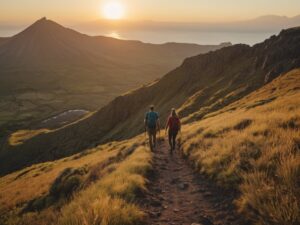
Home / Information
Don’t miss out on this unforgettable experience! Our Trekking Tour and Package is the perfect way to witness the magic of Bali. Contact us to book your adventure!

Hiking Mount Agung, Bali’s highest and most sacred volcano, is a thrilling adventure that attracts trekkers from around the world. Standing at an impressive 3,031 meters (9,944 feet), this majestic peak offers breathtaking views, diverse landscapes, and a spiritual connection to the island’s culture. If you’re planning to hike Mount Agung, here’s everything you need to know to make the most of your experience.
Mount Agung is not just the tallest volcano in Bali; it holds significant religious importance to the Balinese people. The mountain is considered a sacred site, and many temples, including the renowned Pura Besakih, can be found on its slopes. With its last major eruption occurring in 1963, hikers are both captivated by its beauty and cautious of its volcanic activity.
There are two main trails to summit Mount Agung:
**1. Besakih Temple Route:**
This route is longer (approximately 6-7 hours to the summit) but is considered the more scenic option. It begins at the Besakih Temple and offers hikers a stunning view of the surrounding rice fields and valleys.
**2. Pasar Agung Temple Route:**
This shorter and slightly steeper route typically takes about 4-5 hours to reach the summit. It starts at Pasar Agung Temple and is favored by those looking for a more challenging trek.
The ideal time to hike Mount Agung is during the dry season, which lasts from April to October. Morning treks starting around midnight or early morning (1:00 AM to 3:00 AM) are popular for catching the spectacular sunrise at the summit. Keep an eye on weather forecasts, as visibility and temperature can greatly impact your hiking experience.
Hiking Mount Agung requires a good level of physical fitness. The terrain can be challenging, with steep inclines, rocky paths, and varying weather conditions. To prepare, engage in regular cardiovascular training, such as hiking, running, or cycling, to build stamina and strength. It’s essential to start your preparation a few weeks prior to your hike.
Having the right gear is crucial for a successful hike. Here’s what you should consider bringing:
– **Footwear:** Wear sturdy, comfortable hiking boots with good grip to navigate rocky terrain.
– **Clothing:** Dress in layers to manage temperature changes. A moisture-wicking base layer, insulation, and a waterproof jacket are recommended.
– **Backpack:** A lightweight daypack can hold your essentials, including water, snacks, a first-aid kit, and extra layers.
– **Headlamp or Flashlight:** If you’re starting early, a reliable light source is essential for navigating in darkness.
Staying hydrated is vital during your hike. Carry at least 2 liters of water, and consume it regularly. High-energy snacks, such as nuts, trail mix, or energy bars, will help fuel your ascent. Consider starting with a light meal high in carbohydrates before your trek.
When hiking Mount Agung, it’s essential to respect the local customs and environment.
– **Follow the Trail:** Stay on marked paths to protect the vegetation and prevent erosion.
– **Leave No Trace:** Carry out everything you bring, including trash and leftover food.
– **Listen to Your Guide:** If you opt for a guided trek, heed their advice regarding your pace and safety. They have valuable knowledge about the area and potential hazards.
Upon reaching the summit, you’ll be rewarded with stunning panoramic views of Bali, including the coastline and surrounding mountains. Take your time to soak in the scenery and capture memorable photos. As Mount Agung is a sacred site, show respect by observing any local customs or rituals at the summit.
Descending can be as challenging as the ascent, so take precautions. Use shorter, slower steps to maintain balance and avoid injuries. Be mindful of your footing on rocky and steep sections, and make sure to stay hydrated.
Once you’ve completed your hike, consider visiting nearby attractions, such as local temples or hot springs, to relax and experience more of Bali’s culture. Enjoy a well-deserved meal at a local restaurant to replenish your energy.
Hiking Mount Agung is an unforgettable adventure that offers a mix of natural beauty, physical challenge, and cultural significance. With proper preparation and awareness, you can enjoy a safe and memorable experience. Embrace the journey, and make this trek a highlight of your Bali visit! Whether you’re an experienced hiker or a novice explorer, Mount Agung’s dramatic landscapes and stunning vistas await you. Happy hiking!




Premier tour agency dedicated to providing unparalleled exploration experiences in Bali! Our passion for this beautiful island drives us to offer exceptional tours that showcase Bali’s stunning landscapes, vibrant culture, and breathtaking volcanic wonders.
+62 823-4008-5527
balivolcanoadv@gmail.com
Cempaga, Bangli Regency, Bali, Indonesia 80614